Online exhibits : Special exhibits : Fossil footprints

Fossil footprints through geologic time
III. How do we study fossil tracks?
By Allison Vitkus, Karen Chin, and Martin Lockley
Fossil tracks can provide different types of information about the lives of the animals that made them. By examining the shapes of tracks, researchers learn about the characteristics of the track-maker's feet. By measuring trackways (series of at least three consecutive tracks), researchers learn about the posture of animals and how they moved. And by analyzing multiple trackways, researchers can find clues about how ancient animals interacted with each other.
Paleontologists begin looking for fossil tracks much like they would hunt for other fossils. The first thing they do is study geologic maps to determine the age of sedimentary rocks exposed on the Earth's surface. It is also important to recognize that some sediments are more likely to contain fossil tracks than others (see How tracks are preserved). Furthermore, certain animals only lived during certain time periods. For example, if a person wants to study pterosaur tracks, they must examine rocks from the Mesozoic Era, which is the only time in Earth history during which pterosaurs lived. Once paleontologists identify sedimentary deposits that are likely to have fossil tracks, they can search the area for tracks that have been exposed by erosion.
Fossil track analysis
When researchers find fossil tracks, they photograph, measure, and record notes about them. It is important to record as much information as possible about any fossil while it is still in place in the ground (in situ) so that information isn't lost. Scientists note the shapes and orientations of tracks, the positions of the tracks relative to each other, the geological context (age and type of rock), and the exact location of the site. They also take photographs with a size reference (such as a centimeter scale) and often trace the positions of a series of tracks on see-through material such as acetate.
Scientists who study tracks prefer to collect them so they can be stored in a museum and will be available for study by other researchers in the future. But fossil tracks and trackways are made of rock and can be quite heavy! Furthermore, it can be illegal to remove fossil tracks from some sites, or it might be preferable to keep them in place for visitors to observe. Thus it may not always be possible or practical to remove fossil tracks from the ground. In such circumstances, scientists can do some analyses in the field that might otherwise be done in a museum or laboratory. Making molds of tracks out of latex is particularly useful because researchers can use latex molds to make positive casts of the tracks from plaster or other materials. This allows study of the three-dimensional details of tracks when originals cannot be collected. This process must be done carefully, because making replicas can damage the original specimens. Researchers can also make tracings of tracks and trackways in order to document the track patterns and compare them to other tracks and trackways. Another way to record tracks is by using 3D photogrammetry, a technique which uses computer software to combine multiple photos of an object taken from different directions and angles into one 3D digital model of that object.
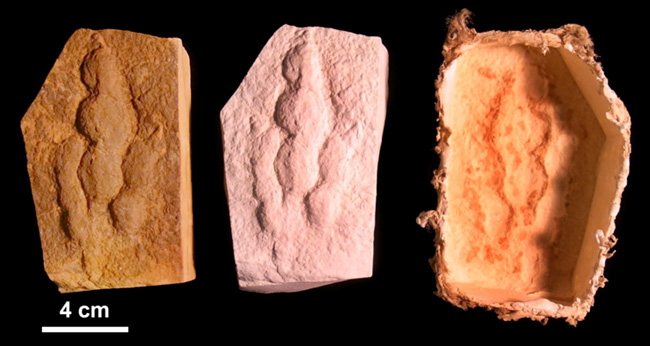
Measuring fossil footprints
Paleontologists measure several different features of fossil footprints. The length and width of a track as well as the lengths of the impressions of digits (fingers or toes) provide basic data on foot morphology (shape and structure). Footprints made with hind feet are called pes tracks, while those made with front feet are called manus tracks. Additional measurements are made of trackways, including step, stride, trackway width, and pace angle. Step is the distance between two consecutive (left and right) tracks. Stride is the distance between two tracks made by the same foot. Trackway width is, as it sounds, the measure of the entire width of the trackway. Pace angle is the angle between two consecutive step lengths. These measurements offer information regarding the posture and speed of the track-making animal. For example, animals that make tracks with relatively short strides and wide straddles generally have a sprawled posture and carry themselves close to the ground, like lizards and crocodilians. Conversely, animals that make tracks with relatively long strides and narrow straddles usually have an upright posture and walk with their legs held straight under their bodies. Animals that walk with an upright posture include dinosaurs, elephants, and humans.
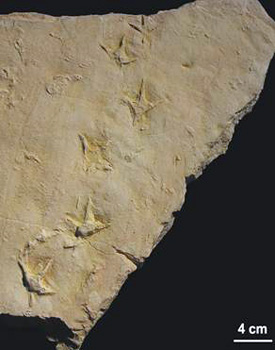
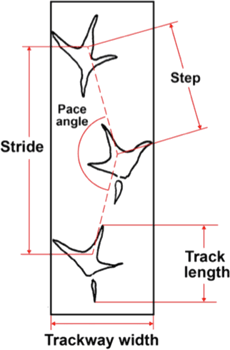
Other analyses
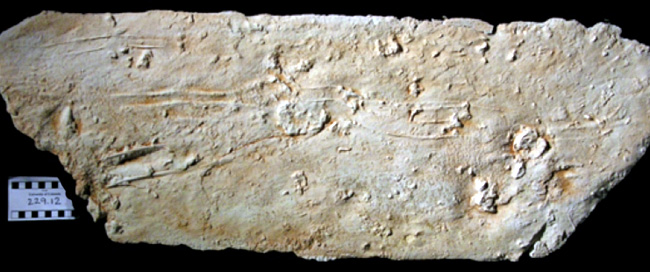
Classifying and naming fossil tracks
Classifying tracks is challenging because there are two confusing issues. First of all, one type of track may have been produced by many unrelated animals. Conversely, one animal is capable of making many different types of tracks or traces. For these reasons, it is difficult to classify fossil tracks by evolutionary relationships in the way that biologists classify organisms. Nevertheless, researchers typically classify fossil tracks using a binomial system that is similar to the Linnaean system which assigns each type of organism a genus and species name (such as Homo sapiens for humans). It is important to note that the designations for fossil track types are called "ichnogenera" and "ichnospecies" to distinguish these as trace fossil names that do not provide information about evolutionary relationships. For example, the common theropod dinosaur track, Grallator, has been found in sediments dating from the Triassic to the Cretaceous — thus it was almost certainly made by several different species of theropod. Researcher may also assign several names to traces that were produced by one type of organism that was doing different things. Trilobites are thought to have made both the fossil trail Cruziana and the fossil resting trace Rusophycus.
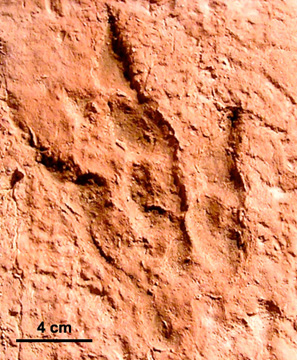
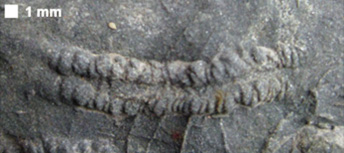
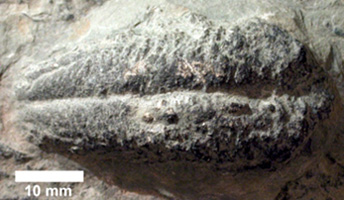
When studying new fossil tracks, the first order of business is to investigate whether comparable tracks have already been described. Researchers examine specimens at other museums and search the scientific literature to look for fossil tracks that have features that are similar to the tracks they are studying. If the tracks have not been described before, the researcher can designate a new ichnotaxon name. As in biology and other areas of paleontology, scientists name fossil tracks after a variety of things. Common naming inspirations include the location in which the tracks were found, people who have played important roles in the research, or descriptive features of the tracks. Brasilichnium is an ichnogenus of tracks first found in Brazil. The species name of the bird track Ignotornis mcconnelli was named after N.H. McConnell, the man who first found the tracks and donated them to the University of Colorado Museum of Natural History. Octopodichnus is an ichnogenus name that means "eight-footed trace." It was made by an arthropod — almost certainly a spider.
Paleontologists can also name tracks after the presumed trace-maker. Pteraichnus, for instance, is an ichnogenus that gets its name from the pterosaurs who are thought to have made the tracks. However, it is impossible to be completely sure exactly which type of animal made a specific type of track unless a body fossil of that animal was found at the end of its trackway. Tracks in which the fossil of the track-maker is present at the end of the trackway are extremely rare and are called mortichnia; "mort" is Latin for mortal or death and refers to the animal's final trail. One example of mortichnia is a horseshoe crab body fossil that was found at the end of its trackway in Jurassic sediments in Germany.
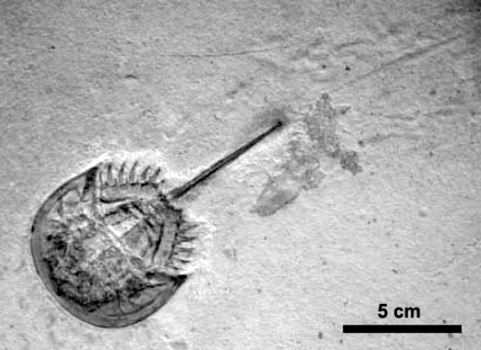
Determining who made fossil tracks
Scientists can also compare fossil tracks to footprints made by living animals. Some paleontologists have performed experimental studies that have recorded the tracks that modern animals make in various types of sediment with different moisture contents. Such studies help us interpret fossil tracks. For example, some research has compared modern scorpion tracks in sand to the fossil trackway Paleohelcura. Interestingly, modern scorpions have been observed to make different types of tracks at different temperatures.
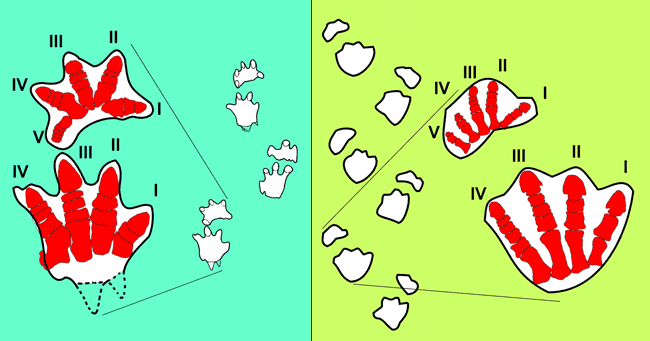
New information sometimes makes it necessary to rename established ichnogenera or ichnospecies. Researchers who rename and reorganize ichnogenera are often categorized as "lumpers" or "splitters," depending on how they re-categorize the tracks. "Lumpers" contend that some ichnotaxa should be combined, whereas "splitters" argue for creating new names for specimens that are currently assigned to a single group. Lumpers and splitters can be found in other areas of biology and paleontology — not just the study of fossil tracks!
References
Brady, L.F. 1947. Invertebrate tracks from the Coconino Sandstone of Northern Arizona. Journal of Paleontology 21(5):466-472.
Farlow, J.O., R.E. Chapman, B. Breithaupt, and N. Matthews. 2012. The scientific study of dinosaur footprints. Pp. 713-759 in M.K. Brett-Surman, T.R. Holtz, Jr., and J.O. Farlow (eds.), The Complete Dinosaur, second edition. Indiana University Press.
Keighley, D.G., and R.K. Pickerill. 1996. Small Cruziana, Rusophycus, and related ichnotaxa from eastern Canada: The nomenclatural debate and systematic ichnology. Ichnos 4(4):261-285.
Li, R., M.G. Lockley, M. Matsukawa, K. Wang, and M. Liu. 2011. An unusual theropod track assemblage from the Cretaceous of the Zhucheng area, Shandong Province, China. Cretaceous Research 32(4):422-432.
Lockley, M.G., and A.P. Hunt. 1995. Dinosaur Tracks and Other Fossil Footprints of the Western United States. Columbia University Press, New York. 338 pp.
Lockley, M.G., and C.A. Meyer. 2000. Dinosaur Tracks and Other Fossil Footprints of Europe. Columbia University Press, New York. 360 pp.
Lockley, M., K. Chin, K. Houck, M. Matsukawa, and R. Kukihara. 2009. New interpretations of Ignotornis, the first-reported Mesozoic avian footprints: Implications for the paleoecology and behavior of an enigmatic Cretaceous bird. Cretaceous Research 30(4):1041-1061.
Lomax, D.R., and C.A. Racay. 2012. A long mortichnial trackway of Mesolimulus walchi from the Upper Jurassic Solnhofen Lithographic Limestone near Wintershot, Germany. Ichnos 19(3):175-183.
McCrea, R.T., M.G. Lockley, and C.A. Meyer. 2001. Global distribution of purported ankylosaur track occurrences. Pp. 413-454 in K. Carpenter (ed.), The Armored Dinosaurs. Indiana University Press: Bloomington, Indiana.
1UCM refers to the University of Colorado Museum of Natural History. The collection was originally built by the University of Colorado Denver, and was displayed at the Dinosaur Tracks Museum on the Denver campus. The fossil tracks are now housed at the University of Colorado Museum of Natural History in Boulder, Colorado, and the images of these specimens are courtesy of the University of Colorado.